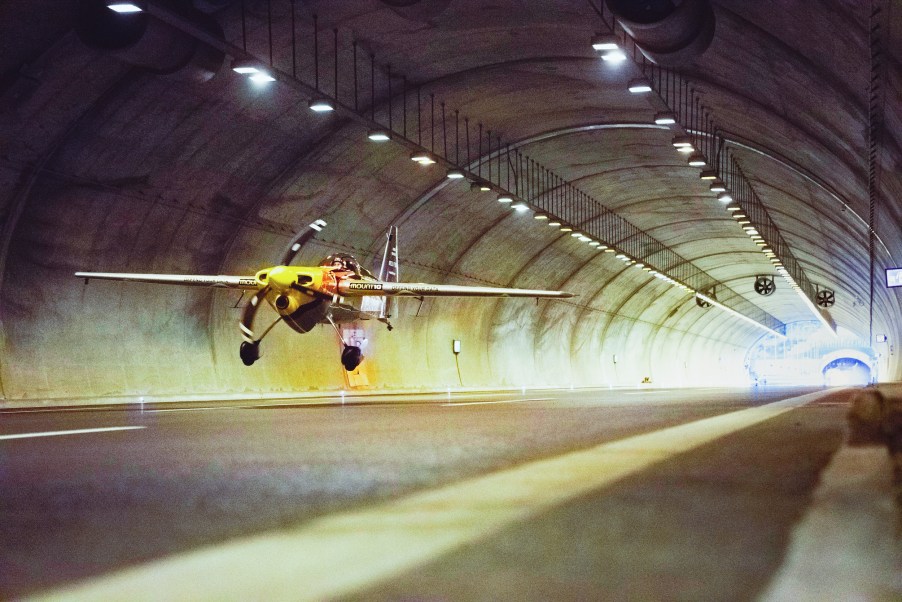
This Stunt Pilot Just Set Five World Records Flying an Airplane Through a Tunnel
If you’ve ever played Grand Theft Auto V, then you’ve certainly attempted flying through the tunnel under the military base. But Italian stunt pilot Dario Costa did just that in real life, flying a plane under a tunnel along the Northern Marmara Highway in Turkey. The stunt wasn’t a one-man effort, working with a team of 40 Red Bull engineers to calculate the flight path, modify the airplane, and complete the feat with no casualties. Talk about Red Bull giving you wings.
Everything you need to know about the world’s first tunnel flight
For starters, let’s talk about the “specs” of this aviation feat. The tunnel selected right outside Istanbul was just over a mile long, and the four lanes made it about 51 feet wide. That left just 13 feet from wing to wall as Costa would navigate the tunnel. And his reaction times had to be fast, 250 milliseconds fast, in order to keep the airplane straight.
Costa took off at 6:43 am from one tunnel and got airborne by the time he entered the other. The early liftoff was chosen due to enhanced visibility, with the morning sun behind him. From there, Costa stayed between 2.2 ft and 5.2 ft off the ground, to make sure he didn’t bang into the floor or the ceiling.
But, as you’ve likely guessed, Costa made it out the other end, performing well-earned barrel rolls upon exiting. After all, he’d just set five Guinness World Records. The main objective was the longest flight in a tunnel with an airplane. But other “accidental” records included the first airplane flight through a tunnel, longest flight under a solid obstacle, first airplane takeoff from a tunnel, and first airplane flight through two tunnels (since he took off from the first one).
The flight lasted 44 seconds, and he got the stunt plane up to speeds of 152 miles per hour. A crash at that speed, in that tight space, would’ve been deadly. But every foreseeable problem was planned for well ahead of time.
The risks were calculated, and there were a lot of them

From the very beginning, when the airplane was ready for takeoff, there were challenges to overcome. Because of the architecture of the highway, Costa had to liftoff from a different tunnel. That meant he couldn’t simply “pull up,” otherwise he’d smash into the ceiling. Instead, he had to keep the airplane straight, with very little vertical movement, to line up for the actual tunnel run.
Now, if you know anything about crosswinds, you know that they can shake and rattle a plane around. Because the entrance to the main tunnel is outside, that experiences the elements, whereas the inside of the tunnel is less affected. The air is still inside the tunnel, while the wind outside is, for lack of a better term, windy. That’s a sudden increase in lift that the pilot has to take into account, otherwise, they’ll scrape the ceiling.
The same is true for the opposite when Costa exited the tunnel. You’ll notice he rapidly pulled up, and while part of that may have been celebratory, some of it was strategic. Because the wind would rapidly push the stunt plane toward the ground, the pilot would have to pull up quickly to counter the effect.
Now, had the tunnel been perfectly straight, and perfectly flat, this would’ve been a cakewalk. But this pass had subtle changes in elevation and slight curves that Costa had to take into account. In fact, the tunnel itself was mapped out by lasers so Costa could practice in simulators. In other words, a lot of preparation went into making this record possible.
Dario Costa had been dreaming of and training for this stunt for years

Costa’s logic behind the stunt was simple: “I’d never flown in a tunnel in my life – nobody had ever done it.” And at 41 years old, with over 5,000 hours in the air (half of it stunt related), Costa was just the man for a task. As mentioned, he trained with simulations that 3D rendered his airplane in the tunnel. That measured exactly what path he needed to fly, and how he’d achieve it.
But on top of that, Costa had to train at the Red Bull Athlete Performance Center in order to get his reaction times down to the 250 milliseconds it needed to be at. For reference, a blink is roughly 100 to 150 milliseconds, and that’s without the added stress of piloting a stunt plane.
Oh, and Costa wasn’t the only thing precision-engineered to tackle the stunt. The airplane itself was a modified Zivko Edge 540, which had new materials to increase lift and reduce weight. That, paired with a Formula One concept racing seat, and other weight reductions, made it the right tool for the job.
And for added training, Costa was granted permission to blast down the highway in a car. This would simulate the speed of the aircraft, though we can’t help but think that was also a blast. The whole stunt is an impressive show of the stunt pilot’s aviation skills, and it’ll certainly be tough to top.


